The Economics and Statistics Division maintains archives of previous publications for accountability purposes, but makes no updates to keep these documents current with the latest data revisions from Statistics Canada. As a result, information in older documents may not be accurate. Please exercise caution when referring to older documents. For the latest information and historical data, please contact the individual listed to the right.
<--- Return to Archive
For additional information relating to this article, please contact:
January 27, 2022EMPLOYMENT, EARNINGS AND HOURS, NOVEMBER 2021 PAYROLL EMPLOYMENT
With November reference month results, year-over-year (November 2021 vs November 2020) and year-to-date (Jan-Nov 21 vs Jan-Nov 20) shows the rebounds in economic activity from the unprecedented declines observed at the start of the COVID-19 pandemic.
Nova Scotia had 428,691 payroll employees in November 2021, up 1.0% (+4,435) compared to October 2021, and up 4.5% (+18,450) compared to November 2020. Nova Scotia's payroll employment had been trending upwards since 2017 but declined sharply between February and May 2020 due to restrictions and closures resulting from COVID-19. There was a partial rebound from June to November 2020 due to eased restrictions. In December 2020, Nova Scotia's payroll employment edged down once again on renewed COVID-19 restrictions. Nova Scotia's payroll employment returned to a path of recovery starting in January 2021. Nova Scotia imposed restrictions again at the end of April. These restrictions were eased part-way through June to November 2021. Nova Scotia's payroll employment returned again to a path of recovery starting in June 2021. Nova Scotia's payroll employment has been above its pre-pandemic level since October 2021.
Canada had 17.0 million employees, an increase of 0.2% (+37,184) compared to last month and up 6.5% (+1,041,441) compared to a year ago.

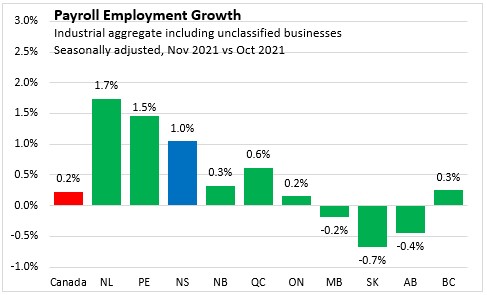
Compared to February 2020, Nova Scotia's payroll employment was up 1.2% in November 2021. Nationally, payroll employment was down 0.4% in November 2021, with four provinces reporting lower employment compared to February 2020. The largest payroll employment declines were observed in Alberta (-2.3%), Newfoundland and Labrador and Ontario (both at -1.6%). The largest increases were reported in New Brunswick (+3.2%) and Prince Edward Island (+2.9%).

In Jan-Nov 2021, Nova Scotia's payroll employment increased 5.9% over Jan-Nov 2020. Nationally, payroll employment rose 5.7% in Jan-Nov 2021, with all provinces reporting increases. The largest payroll employment increases were observed in Prince Edward Island (+8.3%), New Brunswick and British Columbia (both at +6.9%). The slowest payroll employment growth was observed in Alberta (+4.7%).

In January-November 2021, payroll employment was up 5.9% in Nova Scotia's goods producing sectors compared to January-November 2020. Goods sector payroll employment was up in all sub-sectors with construction (+7.9%) recording the largest gain.
Service sector employment was up 6.0% in January-November 2021 compared to January-November 2020. Service sector payroll employment increased the most in percentage terms in arts, entertainment and recreation and management of companies. Payroll employment decreased in real estate/rental & leasing.

AVERAGE WEEKLY EARNINGS
Changes in average weekly earnings reflect wage growth as well as changes in the composition of employment by industry/occupation/experience, and average hours worked per week. During COVID-19, large employment losses have been reported in industries with relatively low average weekly earnings. This means that average weekly earnings were increasing because those remaining employed are working in industries with higher average weekly earnings. Declining average weekly earnings may similarly reflect re-employment in lower wage industries.
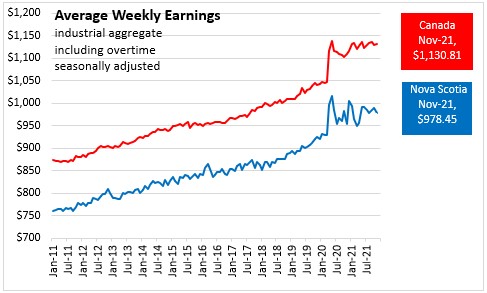
Nova Scotians' average weekly earnings (including overtime, seasonally adjusted) decreased 1.0% (-$10.18) from October 2021 to $978.45 in November 2021. Average weekly wages were up 2.7% compared to November 2020. Canadians' average weekly wages edged up 0.1% month to month ($1,130.81 in November) and were 1.9% above wages a year ago.
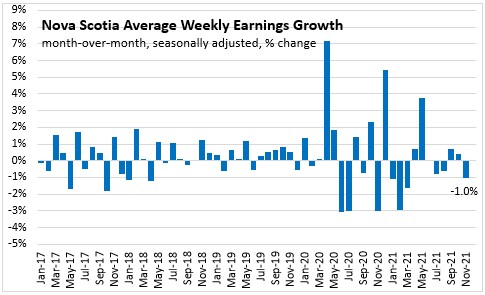

Across the country, there were monthly increases in four provinces, with the largest increases in Newfoundland and Labrador, Quebec, and Alberta (at +0.7%). The largest decrease was in Prince Edward Island (-2.2%).
Compared to a year ago, average wages were higher in all provinces except Prince Edward Island (-1.2%), with Alberta (+3.0%) recording the largest gain.
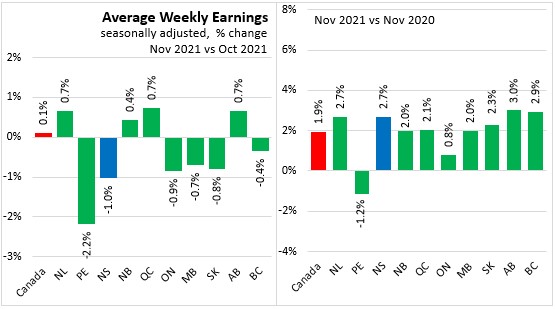
Compared to February 2020, average wages were higher in all provinces, with the largest increases in percentage terms reported in British Columbia (+10.4%) and Quebec (+9.2%). The slowest growth in average weekly earnings was observed in Prince Edward Island (+3.5%).

Compared to January-November 2020, Nova Scotia's average wages were up 1.5% in January-November 2021. Nationally, average wages were up 3.1% in the first eleven months of the year. Average wages were higher in eight provinces, with the largest increases in percentage terms reported in British Columbia (+4.2%) and Ontario (+3.7%). Average wages were lower in Prince Edward Island (-0.1%) while unchanged in Newfoundland and Labrador.
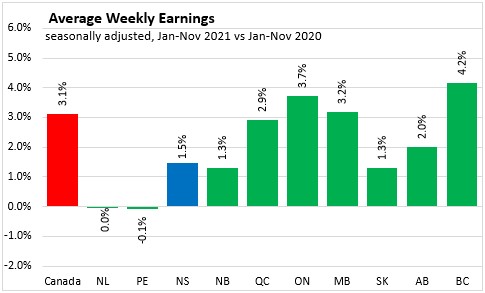
In January-November 2021, average weekly earnings were up 3.4% in Nova Scotia's goods producing sectors over January-November 2020. Goods sector wages were up for construction and manufacturing sectors. Service sector average earnings were up 1.0% in January-November 2021. Service sector earnings increased the most in percentage terms in finance and insurance (+5.2%) and administration and support services (+5.0%). Service sector earnings decreased the most in information and culture (-2.3%).
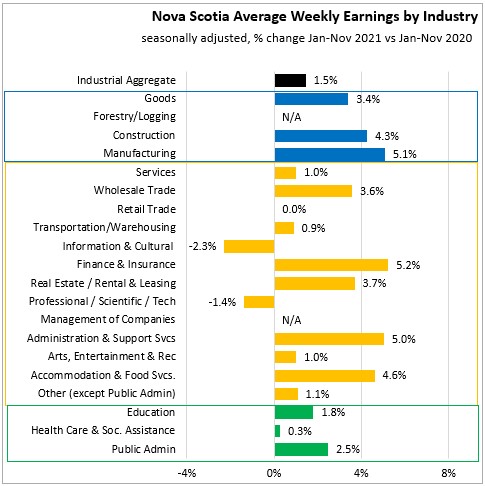
REFERENCE TABLES - (January-November 2021 vs January-November 2020)
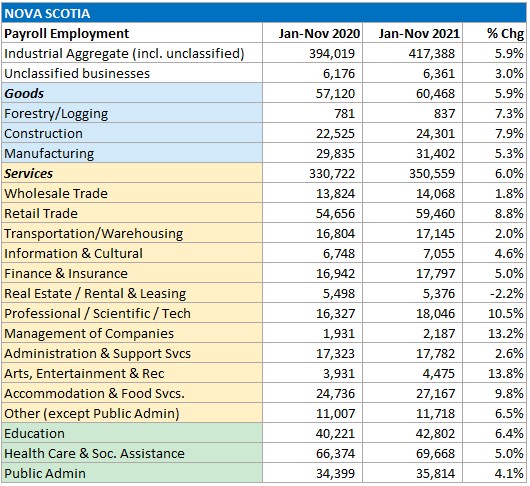
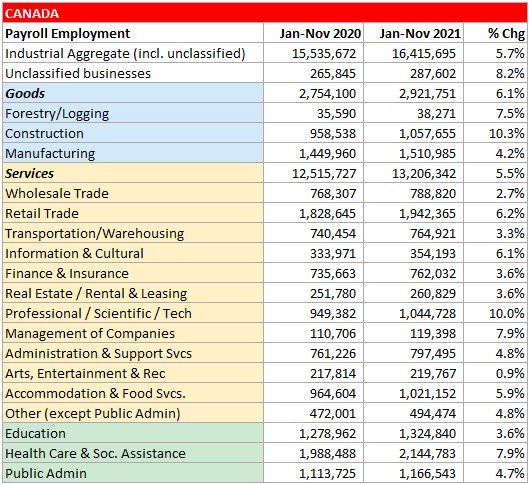
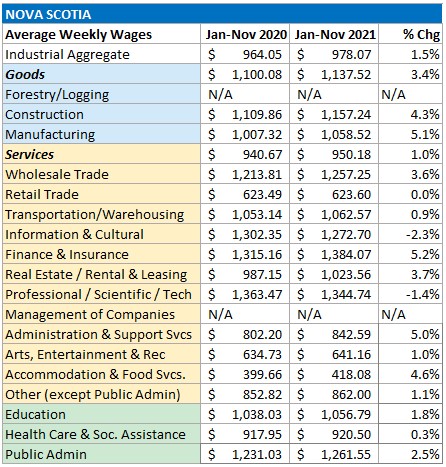
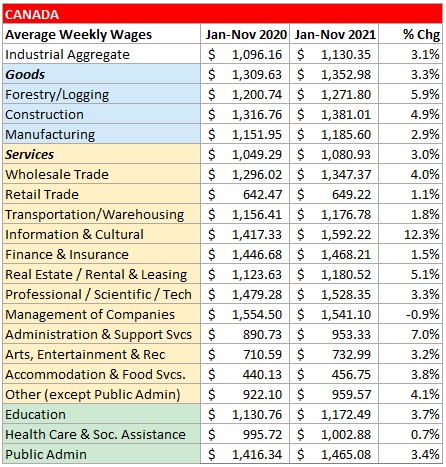
Source: Statistics Canada. Table 14-10-0222-01 Employment, average hourly and weekly earnings (including overtime), and average weekly hours for the industrial aggregate excluding unclassified businesses, monthly, seasonally adjusted; Table 14-10-0223-01 Employment and average weekly earnings (including overtime) for all employees by province and territory, monthly, seasonally adjusted
<--- Return to Archive